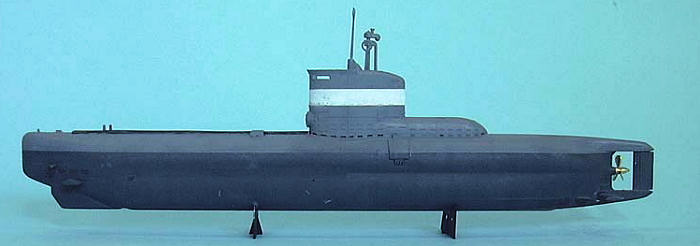
Trumpeter 1/144 Type XXIII U-boat
| KIT #: | 5907 |
| PRICE: | $22.99 MSRP |
| DECALS: | Three Options |
| REVIEWER: | Tom Cleaver |
| NOTES: |

| HISTORY |
From the beginning of submarine
warfare in the First World War, the restricted coastal waters surrounding Europe
- the Baltic Sea, the North Sea, the English Channel - presented restricted
areas for standard U-boats to operate.
The Deutsche Kriegsmarine was well aware of this when
they commissioned the first U-boats built following the end of the World War,
the Type IIa.
These were small U-boats with crews numbering fewer than 30,
which were handy in these restricted waters.
Unfortunately, these submarines were also restricted in
their performance, and were withdrawn from first-line service in Western Europe
by the end of 1940.
They were later sent down the Danube to the Black Sea,
where they achieved success operating against the Soviet Black Sea Fleet.
By 1943, it was clear that the
standard U-boats - the Type VII and Type IX series - no longer had the
performance to be really successful in the Battle of the Atlantic as it had
evolved.
These submarines were really surface ships that could submerge for a
limited period, during which they had a restricted performance.
Driven underwater by Allied anti-submarine forces, the
Germans 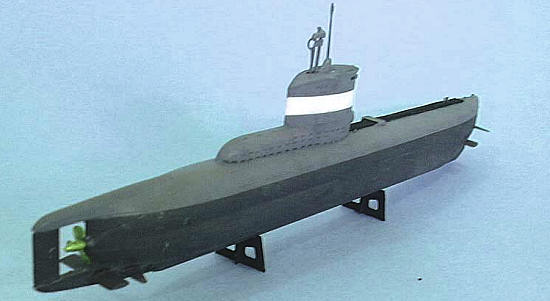 were
faced with a need for new U-boats that were optimized for underwater performance
if they were to have a chance of continuing the decisive Battle of the Atlantic.
were
faced with a need for new U-boats that were optimized for underwater performance
if they were to have a chance of continuing the decisive Battle of the Atlantic.
While the Kriegsmarine focused
primarily on the Type XXI ocean-going “Elektroboat,” there was an additional
requirement for a U-boat of improved performance that could operate in the North
Sea and English Channel.
This requirement also called for a submarine that could
be transported by rail, so that it could also possibly operate in the
Mediterranean without having to make a long sea voyage through the Straits of
Gibraltar to get there.
The result was the Type XXIII.
Development was given very high priority, with emphasis
on a design that could use existing components as much as possible. The Type
XXIII was thus designed to use the MWM RS-348 diesel engine, used as a diesel
generator aboard the Type IX, while the electric motor was the AEG GU 4463/8, a
simplified version of the motors used
on the Type VII. So as to further reduce development,
the design of the new boat was based on the previous Type XXII prototype.
The initial design was approved in late April 1943, and
construction began that June at different shipyards in Germany, France, Italy
and German-occupied USSR, with the lead contractor in charge of the program
being
Deutsche Werft in Hamburg.
The Type XXIII had an all-welded
single hull design, and was the first submarine in the world to use such a
design. It featured a streamlined outer hull; apart from the small conning tower
and a hump which housed the diesel exhaust silencer, the upper deck was
uncluttered.
The U-boat was propelled by a single 3-bladed propeller. As with
the Type XXI, the lower hull section housed a large 62-cell battery.
For rail transport, the hull was broken down into four
sections and the conning tower was removed before being loaded onto a flat car.
Due to its small size, it was armed with only two torpedo tubes, which could
only be loaded externally while in port.
As with the Type XXI, construction
faced a logistical nightmare, with disruptions caused by Allied advances through
occupied Europe, constant aerial attack, and material and manpower shortages.
The first Type XXIII completed was U-2321, which was launched April 17, 1944 and
commissioned June 12, 1944. Of 280 submarines ordered, only 61 entered service
by the end of the war, with the last - U-4712 - being launched on April 19,
1945.
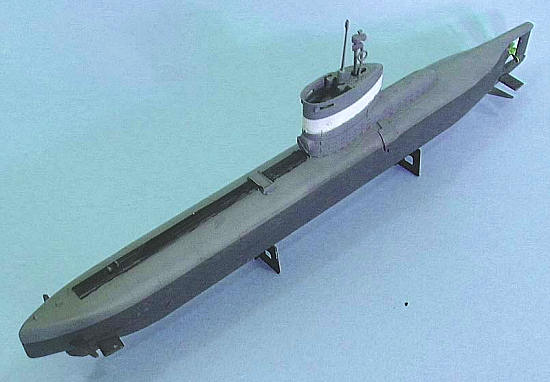 Performance was judged excellent.
Top speed on the surface was 9.7 knots, while maximum
submerged speed on battery power was 12.5 knots, which could be maintained for
an hour.
Operating with a snorkel, maximum speed at periscope depth was 10.75
knots.
On battery power only, the silent speed was 4.5 knots.
All of these figures were superior to those of the
modified Type VII and Type IX boats.
Performance was judged excellent.
Top speed on the surface was 9.7 knots, while maximum
submerged speed on battery power was 12.5 knots, which could be maintained for
an hour.
Operating with a snorkel, maximum speed at periscope depth was 10.75
knots.
On battery power only, the silent speed was 4.5 knots.
All of these figures were superior to those of the
modified Type VII and Type IX boats.
The Type XXIII handled well, being
highly maneuverable both on the surface and underwater. Crash dive time was a
quick 9 seconds, although the crew had to react quickly so as not to exceed the
maximum dive depth of 180 meters.
Operationally, only six boats -
U-2321, U-2322, U-2324, U-2326, U-2329 and U-2336 - are known to have carried
out operational patrols, resulting in five Allied ships sunk by three Type
XXIIIs with no loss to the attacking boats, for a total of 7,392 tons.
U-2336, under the command of
Kapitaen-Leutnant Klusmeier, sank the S.S. “Avondale Park” at 2300 on May 7
1945, which was the last enemy merchant ship sunk during the Battle of the
Atlantic.
This sinking happened approximately one hour after U-2336 sank
its first target, making this the most successful of the Type XXIIIs in action.
Seven Type XXIIIs were sunk before
reaching full operational status, including U-2331, which disappeared on
October 10 1944, while on training in the Baltic, cause
unknown; U2342, which hit a mine in the Baltic on December 26 1944;
U-2344 which sank February 18, 1945, after a collision
with U-2366 while on training in the Baltic;
U-2365, sunk by British aircraft in the Kattegat on May
5, 1945 and
U-2359, also sunk by British aircraft in the Kattegat on May 12,
1945; U-2338, sunk by British aircraft in the Baltic on May 4, 1945; and U-2367,
sunk on May 5 1945, after a collision with another U-boat in the Green Belt
area. 31 Type XXIIIs were scuttled outside Kiel at the end of the war, while 20
were surrendered to the Allies.
Three - U-2326, U-2353 and U-4706 - survived
the war. U-2326 was later the British submarine HMS N-35, while U-2353 became
HMS N-37. U-4706 was handed over to the Norwegian Navy, which commissioned it as
the “Knerten.”
The first XXIII, U-2321, was launched from Deutsche Werft in Hamburg on 17 April, 1944, she was one of the 6 XXIII's that went on operational patrol around the British Isles in early 1945. U-4712 was the last one launched, on April 19, 1945.
| THE KIT |
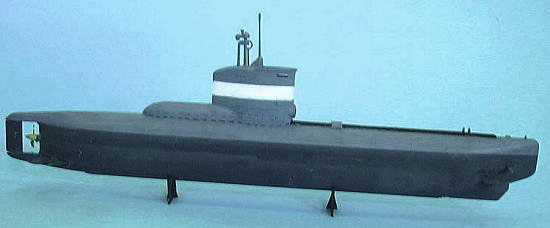 The Type XXIII has been produced
previously by Special Hobby, in 1/72 scale.
This is the first kit of this U-boat in 1/144, which I
consider the optimum scale for submarines, to make them big enough to be
detailed, while small enough to not take up too much space.
The Type XXIII has been produced
previously by Special Hobby, in 1/72 scale.
This is the first kit of this U-boat in 1/144, which I
consider the optimum scale for submarines, to make them big enough to be
detailed, while small enough to not take up too much space.
The kit is the essence of simplicity, with a total of 21 parts needed to make one. Four additional parts are included, these being the parts necessary to make the two optional conning towers which represent other Type XXIIIs produced at different shipyards.
| CONSTRUCTION |
This kit is a perfect “weekend
project.”
Assembly takes all of an hour, if you work slowly.
After allowing the assembled model to set up, it is
ready for paint.
| COLORS & MARKINGS |
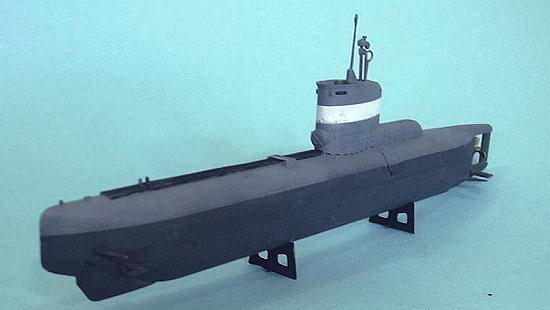 I first painted the white
identification marking with Tamiya “Flat White,” then masked it off.
The lower hull was painted with Tamiya “NATO Black,”
which I later went over using Tamiya “German Grey” to highlight it.
The upper hull and conning tower were painted with
Tamiya “Dark Sea Grey,” while the deck casing was painted with Tamiya “Flat
Black” with a brush, allowing a bit of grey to show through for “weathering.”
The prop was painted with Testors Modelmaster “Brass.”
I first painted the white
identification marking with Tamiya “Flat White,” then masked it off.
The lower hull was painted with Tamiya “NATO Black,”
which I later went over using Tamiya “German Grey” to highlight it.
The upper hull and conning tower were painted with
Tamiya “Dark Sea Grey,” while the deck casing was painted with Tamiya “Flat
Black” with a brush, allowing a bit of grey to show through for “weathering.”
The prop was painted with Testors Modelmaster “Brass.”
| FINAL ASSEMBLY |
I discovered when I went to attach the prop that the pin was too long to allow it to be fitted with the rudder glued in position, so I cut that in half and the prop fit fine. I attached the periscope, snorkel, and radar warning antenna.
| CONCLUSIONS |
This is a very simple kit that
presents no problems whatsoever in assembly, painting and finish.
While the Type XXIII only saw limited operational use,
it is nevertheless an important type in the historical development of the
submarine as an effective weapon of war, and thoroughly deserving of being in
any collection of submarines.
If you would like your product reviewed fairly and quickly, please contact me or see other details in the Note to Contributors.